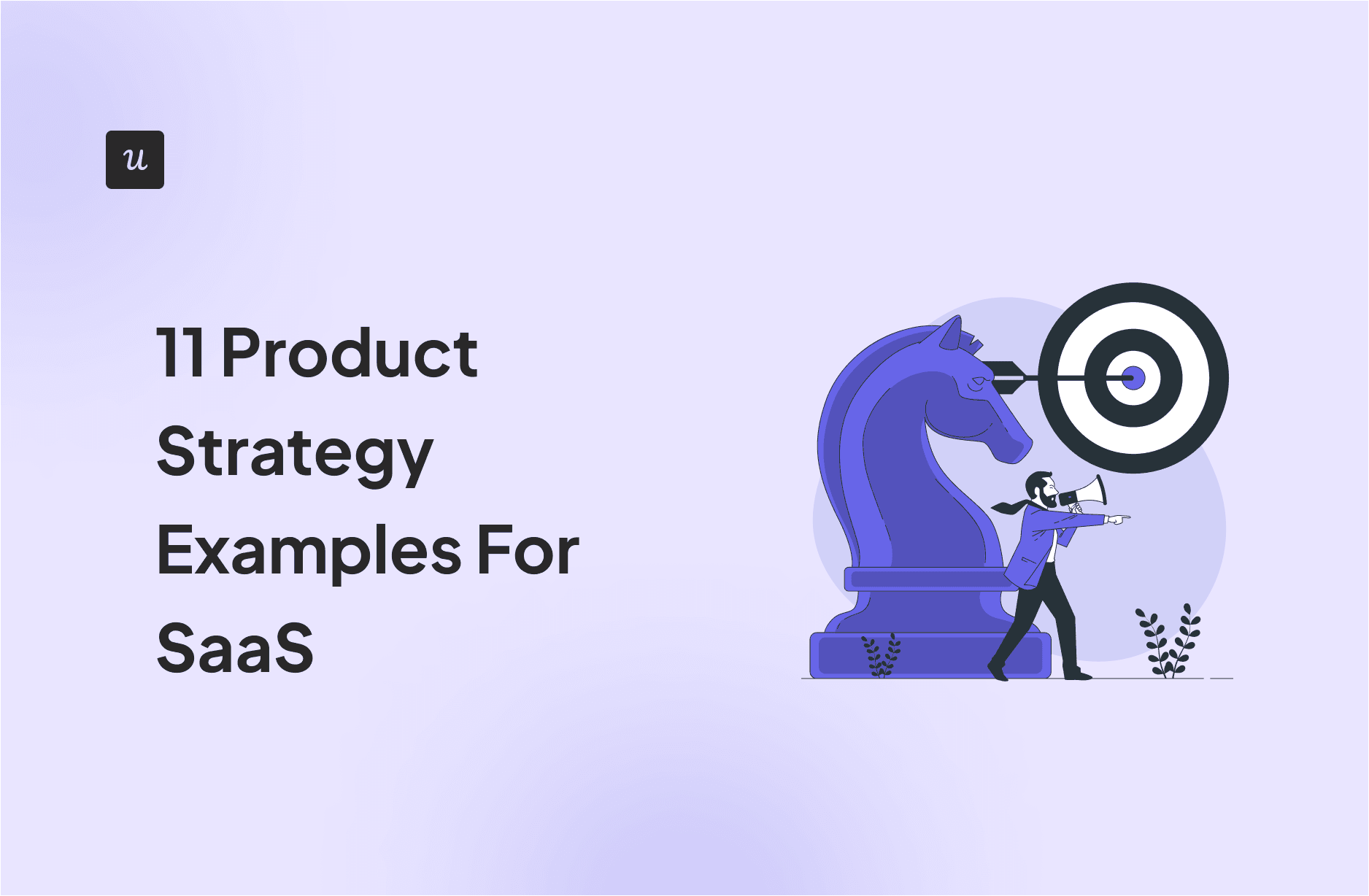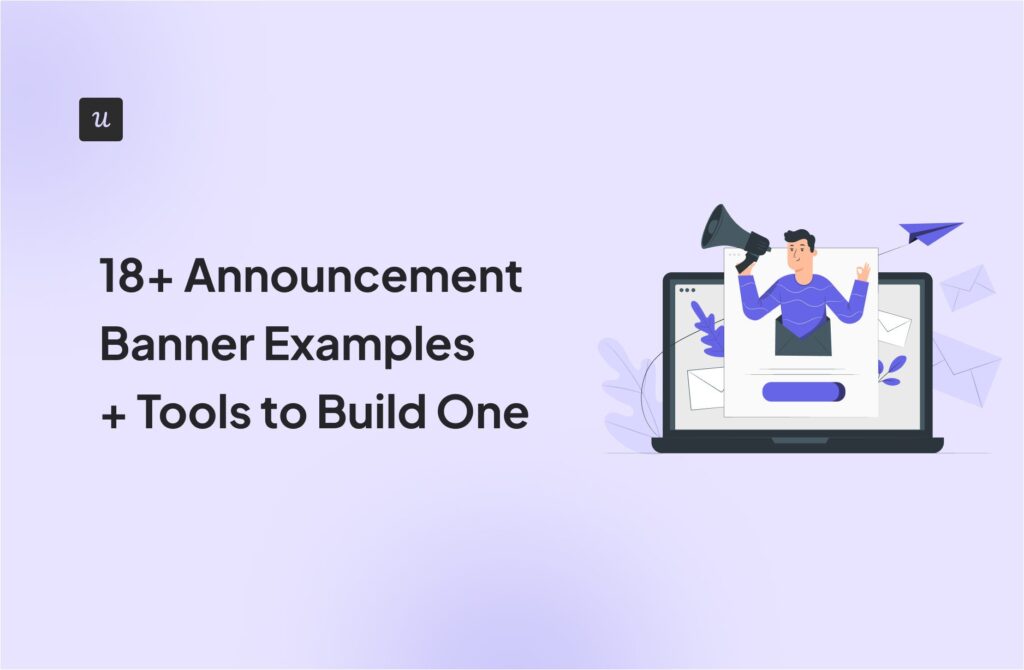
Crafting a winning product strategy is crucial for SaaS success, and finding the right product strategy example can provide all the inspiration you need.
This article provides concrete examples of different product strategies employed by SaaS companies. It also explores ways that SaaS product managers can create an effective product strategy and shape their product’s success.
Try Userpilot Now
See Why 1,000+ Teams Choose Userpilot

What is a product strategy?
A product strategy is an outline or high-level plan that shows how a product will achieve its key goals through its lifecycle.
It’s essentially a roadmap that guides the development process to ensure alignment with the overall business strategy.
Components of a product strategy
A good product strategy should provide clarity for your company, help you prioritize your roadmap, and improve your decision-making. To achieve these goals, it requires three key components:
- Product vision: Your product vision represents the essence of your product. It paints a clear and inspiring picture of your product’s future and its expected impact on users. Essentially, it serves as the “why” behind your product.
- Target market: Also known as your target audience, this is the customer segment your product aims to serve. It is typically broken down into personas – fictional characters that embody your customers’ needs, challenges, etc.
- Product goals: Your product goals are specific, measurable objectives and benchmarks for your product to achieve. They’re often written within set time frames (month, quarter, year, etc.).
- Product initiatives: These are high-level themes of work that you must implement to achieve your goals. Product initiatives are, therefore, the link between your product roadmap and your goals.
How to create an effective product strategy
Although product strategies may differ between companies and industries, product managers generally follow the steps below to create a personalized company strategy.
- Conduct in-depth market research: Study your target market and create detailed customer personas highlighting customer needs, pain points, and goals. You should also understand market trends and analyze the market size, potential, and competition.
- Define your vision: Define a product vision that communicates the long-term goal of your product and the unique benefits it offers customers. This is also the time to define your product’s positioning and unique value proposition (UVP).
- Set product goals: Set goals that are Specific, Measurable, Achievable, Relevant, and Time-bound (S.M.A.R.T). Ensure these goals align closely with your business objectives and contribute to the company’s success.
- Define your product roadmap: Product roadmaps outline the product’s development process (stages, key milestones, and timelines). The roadmap should prioritize features based on customer needs and business goals, and set reasonable timelines for each stage.
- Establish a go-to-market strategy: Your go-to-market strategy should answer questions like: Who will be the target audience for your marketing efforts? How will you reach them? How will you price your product? And what will be your primary strategy for generating leads and driving conversions?
- Define a post-launch strategy: Your post-launch strategy should indicate how you plan to test and adjust your product. Set KPIs for measuring product performance and user engagement. Then, define a data-driven process for adapting your product based on evolving customer feedback and analytics data.
11 Product strategy examples in SaaS
Now that you know how to create your product strategy, let’s consider some successful product strategy examples that you can emulate.
We’ll examine the strategy category for each example to understand it better.
Differentiation strategy
The differentiation strategy focuses on setting your product apart from its competition by highlighting its unique features.
For SaaS products, this often involves integrating exclusive features that are unavailable in other products. This special feature is then highlighted in your market positioning and product messaging to attract customers who need it.
For example, Userpilot differentiates itself through its comprehensive feature suite. It combines user onboarding, product analytics, and user feedback features into one comprehensive product, whereas most products focus on only one of these layers.

Userpilot differentiates by combining multiple feature sets.
Quality strategy
In the increasingly crowded SaaS market, delivering the highest quality product is essential for success. Your goal here is to deliver a product or service that consistently exceeds customer expectations.
The quality product strategy, thus, focuses on providing the highest levels of experience, capability, and reliability. By getting customers to expect the high-end quality you provide, you make it easier for them to buy your product and its solutions.
In addition to a good understanding of customers’ needs, this strategy also requires meticulous attention to detail and robust product testing.
A good example of a quality product strategy is Zendesk, a customer service platform with a comprehensive feature set. It is reputed for its intuitive interface, data security, and reliability, even when handling high volumes of customer interactions.
Cost strategy
The cost strategy is a product strategy that focuses on pricing as a differentiator. It involves offering products at a lower price point and positioning it as the most affordable option among the competitors.
To be effective, this strategy requires that your product maintains a comparable quality to the competition while remaining cheaper than others.
A good product strategy example in this category is Grammarly. Although numerous grammar and writing assistance tools are available, Grammarly has remained affordable without sacrificing its core functionality.
They’ve also maintained a cost leadership position by making their product accessible through a free version that offers basic features. This has allowed them to capture a significant market share.
Focus strategy
The focus strategy involves concentrating on a specific market segment or niche. Rather than trying to be everything to everyone, the focus strategy narrows your gaze to a particular group of target customers.
This approach allows for a deep understanding of customer’s needs, the delivery of tailored product offerings, and a strong competitive advantage within the chosen niche.
For example, Dock provides a tailored workspace for revenue and sales teams. With features like deal rooms, onboarding hubs, content libraries, and client portals, the product is tailor-made to help revenue teams create better sales and onboarding experiences.

Service Strategy
A service strategy focuses on delivering value through better service rather than just the product itself. It involves creating a comprehensive experience for customers by providing exceptional service.
This service can be provided through support, training, consulting, and other value-added services. When implemented correctly, the strategy builds strong customer relationships, boosts customer satisfaction, and increases the customer lifetime value.
Zendesk, mentioned earlier, also incorporates the service strategy. They offer proactive support based on user behavior, actively listen to customer concerns, and work closely with customers to identify pain points and develop solutions.
Zendesk also provides a comprehensive knowledge base for users to find answers independently. The result is a loyal customer base that other SaaS companies aspire to.
Pioneer strategy
Also known as a product leadership strategy, the pioneer strategy involves innovative product development, risk-taking, and investment. It focuses on introducing groundbreaking products or services to a new market.
This means introducing proprietary technology and highlighting it in your positioning to set your product apart in the competitive landscape.
Although it isn’t a SaaS brand, Apple easily comes to mind. Products like the iPhone, App Store, iPod, and iPad were all pioneer products at the time they were released.

Niche strategy
The niche strategy focuses on serving the needs of a narrow and specific user group. This strategy allows product managers to focus on narrowing its features to address the very specific needs of this group.
For example, Freshbooks is an accounting software targeted at freelancers and small businesses. Its features are tailored to the specific needs of freelancers, including invoicing, expense tracking, tax preparation, and time management.
By concentrating on freelancers, Freshbooks can address their unique challenges better than any generic accounting software.
Challenger strategy
A challenger strategy is employed when a company hopes to disrupt a market dominated by a larger, more established player.
Therefore, it involves positioning your product as more exciting based on its features, integration, efficiency, or design to capture a significant market share.
For example, Microsoft Teams was launched in 2016 as a direct competitor to Slack. In addition to the messaging and collaboration features of Slack, it also added a video calling feature.
This added feature, plus its seamless integration into the Microsoft ecosystem, has enabled Teams to overtake Slack as a leading collaboration tool for corporate users.
Equivalence strategy
Also known as the parity strategy, this strategy involves offering a similar product or service to a competitor but with a unique selling point. Thus, it depends on subtle differentiation to capture the market.
Asana and Jira, for example, are cloud-based project management tools that directly compete with each other. These products function similarly, with Jira focusing a little more on product teams and Asana being a little more multi-purpose.
This means that although both products can serve very similar clientele, their slight differences enable them to succeed together.
Requests-based strategy
A requests-based product strategy heavily depends on customer feedback and feature requests to drive the product development process.
This approach involves establishing a robust feedback mechanism to actively listen to customers, collect their requests, and evaluate them against the product vision.
When properly executed, the strategy leads to better customer satisfaction and product-market fit.
Userpilot provides a solid product strategy example in this regard. It provides a passive feedback tab to enable customers to submit their concerns and requests and to enable them to satisfy those needs.

Upselling strategy
Upselling involves persuading existing customers to purchase additional features or a higher-tiered version of a product.
This product strategy serves to increase revenue by solving adjacent problems for customers. In addition to getting these customers to increase their spending, it can also increase the product’s target market.
Loom provides one of the best examples of this product strategy approach. With free users limited to 5-minute video recordings only, they’re immediately prompted to upgrade their account when they reach that limit.
By so doing, Loom takes advantage of the user’s contextual needs to highlight feature gaps and prompt an upgrade that benefits both parties.

Conclusion
A comprehensive product strategy is the backbone of successful products. It provides the direction needed to create a product that resonates with your customers and achieves business objectives.
Whatever your preferred strategy may be, Userpilot’s contextual messaging, feedback collection, and analytics features can aid its success. Book a demo today to learn more!



![10 Free Product Roadmap Templates You Need in 2026 [+Free Download] cover](https://blog-static.userpilot.com/blog/wp-content/uploads/2026/01/10-product-roadmap-templates-you-need-in-2026-free-download_d8269f0b0b9749f6ad7b519ab7ac1833_2000-1024x670.png)



